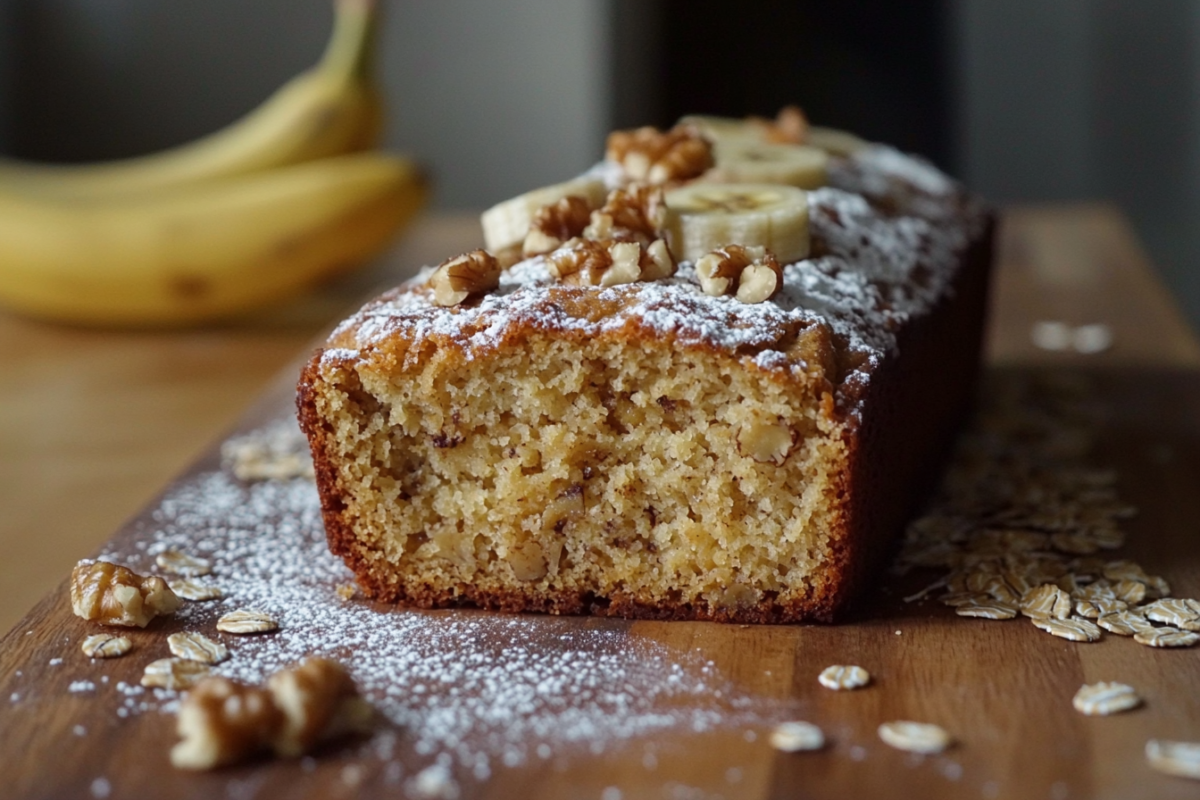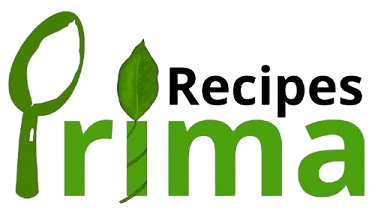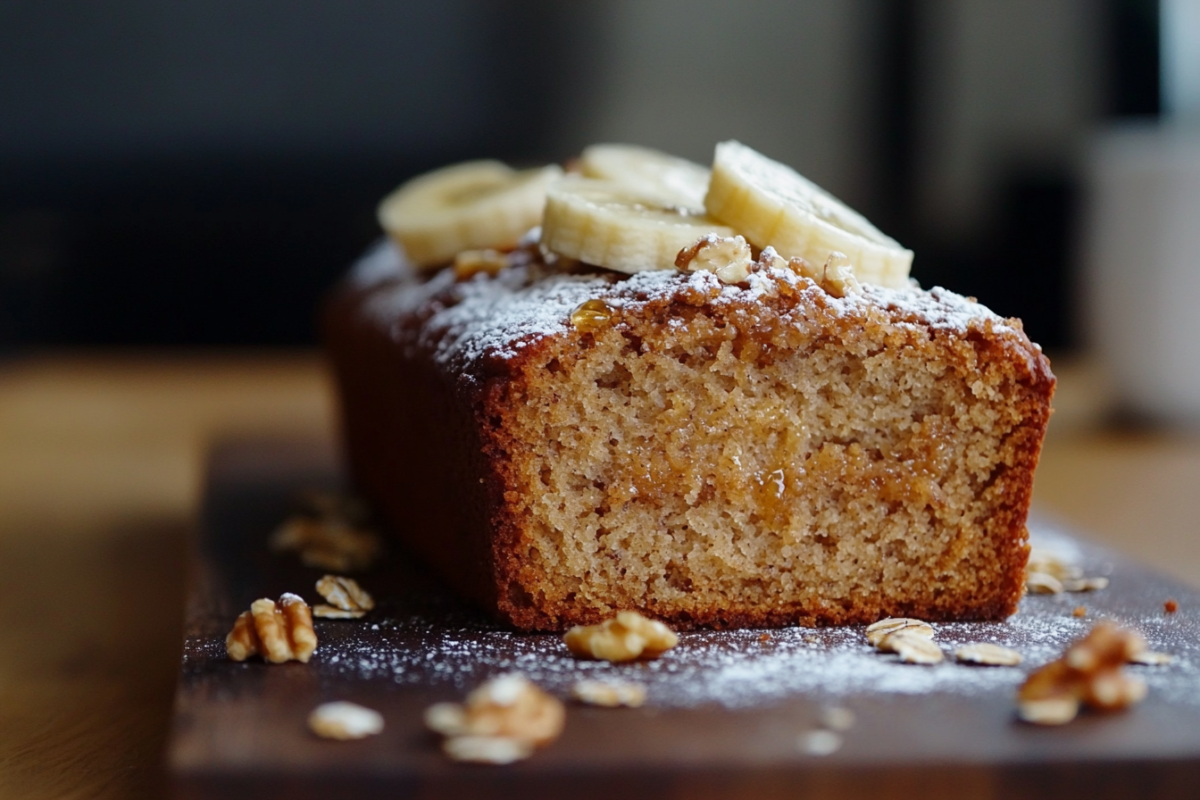Looking for a healthier twist on the classic banana bread? You’re in the right place! In this article, we’ll be diving into a delicious banana bread with oat flour recipe. Not only is this recipe easy to make, but it’s also a great option for those who are gluten-sensitive or want a lighter alternative to traditional banana bread. Packed with nutrients and the goodness of oats, this recipe will quickly become your new go-to treat. Whether you’re baking for breakfast or a snack, this healthy oat flour banana bread has got you covered.
Introduction to Banana Bread with Oat Flour
Banana bread is one of those comforting baked goods that almost everyone loves. It’s moist, flavorful, and perfect for using up those overripe bananas sitting on your counter. But when you swap in oat flour instead of regular flour, you’re not just making a simple change—you’re introducing a healthier twist that can work wonders for both taste and texture. So, why choose oat flour for your banana bread? Let’s dive into that!
Why Choose Oat Flour for Banana Bread?
First off, oat flour is an excellent choice for banana bread because of its mild, slightly sweet flavor. Unlike wheat flour, which can sometimes give baked goods a dense or dry texture, oat flour creates a tender crumb, making your banana bread with oat flour extra soft and moist. Not to mention, oat flour is gluten-free, which makes it perfect for those on a gluten-free diet. It’s also rich in fiber, making it a healthier choice overall.
Additionally, oat flour banana bread brings some nutritional benefits to the table. Oats are known for supporting heart health, keeping blood sugar levels stable, and providing a slow release of energy. So, when you choose oat flour, you’re not just opting for a healthier bread, you’re also getting more fiber, vitamins, and minerals than you would from traditional white flour.
Health Benefits of Oat Flour in Banana Bread
Oat flour isn’t just a tasty alternative to regular flour—it’s packed with health benefits! For starters, oats are rich in beta-glucan, a type of soluble fiber that helps reduce cholesterol levels and boosts heart health. By incorporating oat flour into your banana bread, you’re adding these heart-healthy benefits to your diet.
Another advantage of oat flour banana bread is that it can help stabilize blood sugar levels. Unlike refined flours, oat flour has a lower glycemic index, meaning it doesn’t cause rapid spikes in blood sugar. This makes it a fantastic option for those with diabetes or anyone trying to manage their energy levels throughout the day.
Incorporating oats also provides a boost of plant-based protein, which can help keep you full longer and support muscle repair and growth. Plus, oats are a natural source of antioxidants, helping to fight free radicals and reduce inflammation.
What Makes This Recipe Special?
This banana bread with oat flour recipe is designed to give you all the cozy, familiar flavors of traditional banana bread, with an added health boost. By swapping out the usual flour for oat flour, you get a softer, fluffier texture that’s both satisfying and better for your body.
The recipe also caters to a variety of dietary needs, whether you’re following a gluten-free, vegan, or even dairy-free diet. With simple swaps and minimal ingredients, it’s easy to make this banana bread your own. Additionally, it’s a versatile recipe that you can customize with add-ins like walnuts, dark chocolate chips, or seeds for added texture and flavor.
Ingredients Needed for Banana Bread with Oat Flour
When it comes to making a banana bread with oat flour, the ingredients are simple, yet each one plays a vital role in creating a moist, flavorful loaf. Below, we’ll walk you through the essential ingredients you’ll need for this recipe, plus some helpful substitutions in case you want to make adjustments based on what you have on hand.

Key Ingredients and Substitutions
To start, here are the core ingredients that make up the foundation of this healthy oat flour banana bread:
- Ripe Bananas: The star ingredient in this recipe! The riper the bananas, the sweeter and more flavorful your bread becomes. If you don’t have bananas, you can try substituting with applesauce, though it will slightly change the texture and flavor.
- Oat Flour: As mentioned earlier, oat flour is the key to this recipe. It gives the banana bread a lighter, fluffier texture and adds nutritional benefits. If you don’t have oat flour, you can quickly make it yourself by grinding rolled oats in a food processor until smooth.
- Sweetener: We use maple syrup, honey, or coconut sugar to sweeten the bread naturally. You can adjust the level of sweetness to your taste, or substitute with a sugar alternative if you prefer a sugar-free version.
- Eggs: Eggs act as a binder for the ingredients and aid in the rising process. For a vegan version, you can use flax eggs or chia eggs.
- Baking Soda and Baking Powder: These are essential for giving the banana bread its light and airy texture.
- Coconut Oil or Olive Oil: These oils add moisture and help create a tender crumb. You can substitute with vegetable oil or melted butter if preferred.
The Role of Oat Flour in Banana Bread
Oat flour is not only gluten-free but also adds a unique texture and flavor to your banana bread. Its naturally sweet taste complements the bananas perfectly, making it an ideal base for this healthy dessert. Unlike traditional all-purpose flour, which can sometimes make banana bread dense, oat flour keeps the bread light and fluffy, while still providing a satisfying bite.
Another perk of oat flour is that it’s high in fiber, which contributes to the soft, moist texture of the bread and helps improve digestion. Plus, the health benefits of oat flour—such as its ability to lower cholesterol—make it an even better choice for health-conscious bakers.
Can I Use Gluten-Free Oat Flour?
Absolutely! If you’re following a gluten-free diet or need to accommodate someone who is gluten-sensitive, gluten-free oat flour is the perfect choice. Many store-bought oat flours are naturally gluten-free, but be sure to check the label to confirm it’s certified gluten-free, as some oats may be cross-contaminated with wheat during processing.
Step-by-Step Instructions for Making Banana Bread with Oat Flour
Now that we’ve covered the ingredients, it’s time to roll up your sleeves and get baking! Follow these easy, step-by-step instructions to make your own banana bread with oat flour. With these simple techniques, you’ll be able to whip up a moist and flavorful loaf every time.
Preheat the Oven and Prepare the Pan
First things first, preheat your oven to 350°F (175°C). While the oven is warming up, prepare your loaf pan by greasing it with a little coconut oil or butter. You can also line it with parchment paper for easy removal once the banana bread is done. A 9×5-inch loaf pan is the ideal size for this recipe.
Preparing the Wet Ingredients
Begin by mashing your ripe bananas in a spacious mixing bowl. For the best results, use bananas that are very ripe and spotty—these will bring out the natural sweetness and flavor. Use a fork or potato masher to mash them until smooth, with only small chunks remaining.
Next, add your sweetener to the mashed bananas. Whether you’re using maple syrup, honey, or coconut sugar, stir it into the bananas until well combined. After that, crack your eggs into the bowl and whisk everything together until smooth and fully incorporated. If you’re making a vegan version, now’s the time to add your flax egg or chia egg mixture. Finally, stir in your choice of oil—coconut oil works great here for a slightly tropical flavor, but olive oil or any neutral oil will work just as well.
Mixing the Dry Ingredients
In a separate bowl, combine the dry ingredients: oat flour, baking soda, baking powder, and a pinch of salt. You can also add any optional spices you’d like to include, such as cinnamon or nutmeg, which pair wonderfully with the bananas and oat flour.
Be sure to whisk the dry ingredients together thoroughly to ensure even distribution of the baking soda and powder. This will help your banana bread with oat flour rise evenly during baking.
Combining the Wet and Dry Ingredients
Slowly add the dry ingredients to the wet mixture, using a spatula or spoon to carefully fold them together. Be careful not to overmix the batter—this can make the bread dense. Stir just until everything is well incorporated and there are no more visible streaks of dry flour.
If you’re adding any extras, like chocolate chips, walnuts, or seeds, fold them in at this stage. These additions will give your banana bread some extra texture and flavor.
Baking Time and Temperature
Transfer the batter into the prepared loaf pan, using a spatula to smooth the surface. Place the pan in the preheated oven and bake for 50-60 minutes.Baking times may vary, so monitor it closely as it cooks.
During baking, the banana bread will rise and turn a golden brown on top. To ensure it’s fully baked, set a toothpick or cake tester in the center of the bread. If it comes out clean or with just a few crumbs, your banana bread with oat flour is ready to come out of the oven.
Tips for Perfect Banana Bread Texture
Achieving the perfect texture is key to great oat flour banana bread. Here are a few tips to help you get it just right:
- Don’t overmix the batter: Stir the wet and dry ingredients together just until combined. Overmixing can lead to a dense loaf.
- Choose ripe bananas: The riper they are, the sweeter and more flavorful your banana bread will turn out.
- Add a little extra moisture: If your banana bread feels too dry, try adding a couple of tablespoons of milk (dairy or non-dairy) to the batter.
How to Check for Doneness
To check if your banana bread with oat flour is done, insert a toothpick into the center of the loaf. If it comes out clean or with just a few moist crumbs (but no wet batter), your banana bread is baked to perfection. If it’s still wet, pop it back in the oven for another 5-10 minutes and check again.
Once done, remove the banana bread from the oven and let it cool in the pan for about 10 minutes before transferring it to a wire rack to cool completely. This allows the loaf to firm up and makes it easier to slice.
Tips for Perfect Banana Bread with Oat Flour
Making banana bread with oat flour is straightforward, but a few tips can help you achieve the perfect texture and flavor every time. From ensuring your bananas are ripe to knowing when to stop mixing, these simple guidelines will elevate your baking game and help you make the best banana bread ever.
Make Sure Your Bananas Are Ripe
One of the most important tips for making banana bread with oat flour is to use very ripe bananas. The riper the bananas, the sweeter and more flavorful the bread becomes. Look for bananas with lots of brown spots on the peel—this means they’ve reached peak sweetness. Not only do ripe bananas add natural sweetness, but they also contribute to a moist texture, which is crucial when using oat flour. If you’re in a pinch and don’t have super ripe bananas, you can speed up the ripening process by placing them in a paper bag for a day or two.
Use a Combination of Wet and Dry Ingredients
For the best results, always make sure your wet and dry ingredients are combined properly but not overmixed. Mixing your wet ingredients first ensures that the bananas, eggs, and oil are fully incorporated before you add the dry ingredients. By doing so, you avoid clumping and ensure a smooth batter. Once you add the oat flour and other dry ingredients, fold them gently into the wet mix. This method helps create a light, even texture in your banana bread with oat flour.
Why You Shouldn’t Overmix the Batter
Overmixing the batter is a common mistake when baking banana bread. While it’s tempting to keep stirring to get everything fully combined, too much mixing can cause the bread to be dense and tough. The key is to mix just until the wet and dry ingredients are incorporated—no more! If you see a few lumps, that’s totally fine. It’s better to have a slightly lumpy batter than one that’s been overworked.
Adjusting the Sweetness to Your Liking
Everyone’s taste for sweetness differs, so don’t hesitate to adjust the amount of sweetener to suit your preferences. The bananas already bring natural sweetness to the recipe, but you can add maple syrup, honey, or even a dash of stevia to make it sweeter if you prefer. If you want to cut back on sugar, you can reduce the amount of added sweetener and let the bananas do most of the work. You can also experiment with using coconut sugar for a more caramel-like flavor, which pairs beautifully with the oats.

